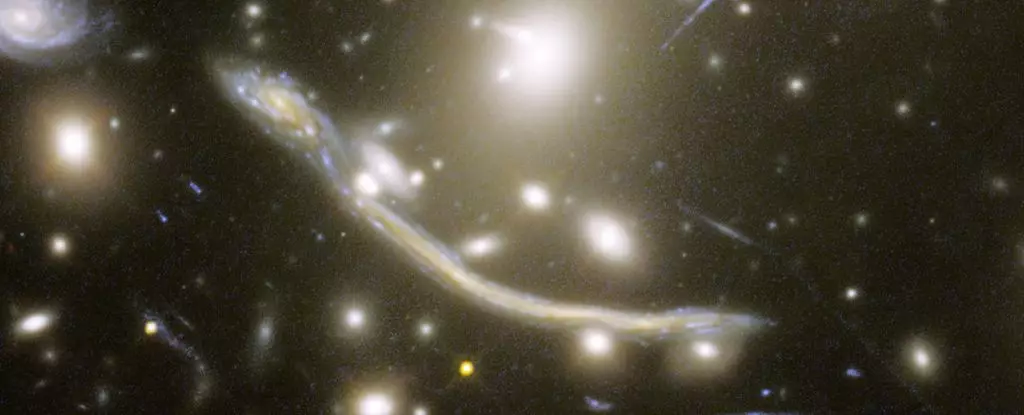The vastness of the cosmos presents an almost incomprehensible barrier when it comes to observing celestial objects, particularly those from the early Universe. With distances measured in billions of light-years, the light reaching our telescopes often comes from sources so far away that individual stars appear as mere points lost in the stellar background. The Hubble Space Telescope has achieved considerable success in astronomical observation; however, its capabilities were fundamentally limited in how many stars could be identified in these distant realms. The dawn of the James Webb Space Telescope (JWST) marks a significant evolution in our observational capabilities. It pushes the boundaries of what is possible, allowing us to resolve many individual stars in galaxies billions of years old, providing insights into the Universe that were previously unattainable.
Recent studies utilizing the JWST have revealed profound discoveries, including the resolution of more than 40 distinct stars in a galaxy whose light has taken nearly 6.5 billion years to reach us. Astrophysicist Fengwu Sun of the University of Arizona heralds this achievement as a groundbreaking moment in the field of astrophysics. “For the first time, we have the capability to study a large number of individual stars within a distant galaxy,” says Sun, underscoring the instrumental role of JWST in expanding our dynamic understanding of cosmic phenomena. In comparison, earlier efforts through Hubble identified only a handful of stars, highlighting the quantum leap in observational power that JWST affords researchers.
The ability to observe such a multitude of stars not only enhances our grasp of stellar evolution but also offers critical insights into the elusive concept of dark matter. This enigmatic form of matter, which is believed to make up a disconcertingly large portion of the Universe, has been a subject of intrigue and speculation for astronomers. With the capacity to observe individual stars, JWST enables astronomers to study the lensing effects produced by dark matter and how it interacts with light in the meridian of said galaxies, further illuminating the structural elements of the cosmos.
The Mechanics of Gravitational Lensing
The phenomenon of gravitational lensing stands at the heart of these remarkable observations. This effect occurs when the fabric of space-time, curved by massive celestial objects, distorts the light emitted by objects behind them, creating multiple images or magnified views of these distant sources. A notable example is the Dragon Arc, a stretched silhouette of light shaped like a Chinese dragon, which results from the gravitational influence of a massive galaxy cluster known as Abell 370. This cluster is approximately 4 billion light-years from Earth and serves as a cosmic vehicle for observing more distant galaxies.
Astronomers have skillfully employed these gravitational effects to reverse-engineer the images received, effectively peeling back the layers obscured by distortion. This process has allowed them to glimpse galaxies as they might appear without lensing, amplifying their visibility in the cosmic landscape. The Dragon Arc presents a unique opportunity to observe stars that were long thought to be isolated due to their distance.
In addition to the amplifying effects of larger galaxies, smaller scale phenomena such as microlensing contribute to our understanding of the stars scattered throughout galaxy clusters. This microlensing effect can provide individual star identification that is otherwise lost amidst the cosmic backdrop. Led by astronomer Yoshinobu Fudamoto of Chiba University, a recent team’s research employed microlensing techniques, leading to the resolution of a stunning 44 stars in the Dragon Arc’s smeared light—a historical first for individual star identification at such distances.
The discovery of these stars sheds light on stellar progression, revealing that many of them are red supergiants—cosmic giants characterized by their massive size and red coloration at the end of their life cycles. In distinction to typically observed hot, blue, and white stars, red supergiants offer an enlightening perspective on the lifecycle of stars, their temperatures, and their luminosity at significant distances.
The advances enabled by the JWST offer an unprecedented view into the complex tapestry of the Universe, paving the way for future studies. Armed with the knowledge and tools provided by this state-of-the-art observatory, scientists expect to uncover even more about the myriad stars residing within the Dragon Arc’s blurry light. This groundbreaking exploration not only enhances our understanding of individual celestial objects but also enriches the larger narrative of galaxy formation and evolution over billions of years. As we venture deeper into the cosmic unknown, the JWST stands as a testament to human innovation and our relentless pursuit of knowledge in the vastness of the Universe.


Leave a Reply